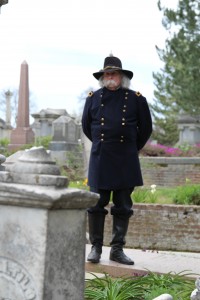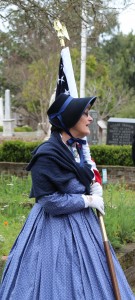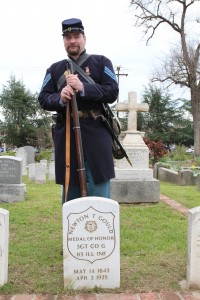
General Wright addressed the audience from his monument.
On Sunday, March 9, Camp 22 hosted a Living Memorial event at the Old City Cemetery in Sacramento. The event began at 10:00AM at the cemetery gate, where Camp Commander Jon Henry presented a brief history of the cemetery. The Sacramento City Cemetery was founded in 1849 on 10 acres donated by Captain John Sutter. Later, Margaret Crocker donated a further 50 acres, and today the cemetery contains more than 25,000 graves.
The Living Memorial was conducted as a walking tour, stopping at the graves of notable Civil War figures. First on the tour was a “visit” with General George Wright, who was the Commander of the Department of California during the war. A graduate of West Point, General Wright explained that he would have much rather been posted somewhere in the eastern theater, fighting alongside his West Point comrades, but President Lincoln personally requested that Wright take command of the West Coast operations and ensure fortifications and troop readiness in the event the Confederacy attempted to interrupt the supply of gold coming from California. Shortly after the end of the war, General Wright was transferred to a command Oregon. On the way to his new post, he and his wife were both drowned in the wreck of the Brother Jonathan off the far northern coast of California. Also lost in the wreck were a number of ladies of a certain profession. At Sunday’s ceremony, the General grieved over the loss of these “soiled doves.” He was also sorry his wife drowned.

Mrs Norris with her famous flag.
The tour continued with a stop at the grave of Rebecca Hall, who was a nurse for the Union Army. One of her first patients was her own husband, who was part of a Wisconsin regiment. She moved west after the war, and unfortunately died destitute. We know her story today only because her War Department pension document and her Service Medal were found for sale in an antique store. Based on this fortunate find, the Veterans Administration was able to supply a military grave stone for Rebecca, who now rests in the north-east corner of the Cemetery.

Lebbeus Simkins (MOH) was at the helm of the USS Richmond at the Battle of Mobile Bay.
Another famous Sacramento lady was Jane Norris. Shortly after the news of Lee’s surrender reached Sacramento in April of 1865, Mrs. Norris performed a rather daring feat in celebration of the Union victory. in 1865, the California State Capitol was still under construction. While the workers were away on their lunch break, Mrs. Norris covertly entered the construction site, and proceeded to climb the scaffolding to the top of the Capitol dome. She placed a US flag on top of the dome, along with a hand written note signed “A Lady.” It was not until after her death that Mrs. Norris was revealed as the person behind this celebratory act.
There are two Medal of Honor recipients in the Old City Cemetery, one sailor and one soldier. The sailor was Lebbeus Simkins, who was a coxswain at the Battle of Mobile Bay. Made famous by Farragut’s “damn the torpedoes” slogan, Mobile Bay was one of the most important strategic victories for the Union in the entire war. Lebbeus Simkins was at the helm of the USS Richmond, which withstood heavy fire from Confederate ships, shore artillery, and even troops with rifles. Although exposed to the fire, Simkins kept the ship on course throughout, and was decorated for his bravery. He lived for a time in San Diego before moving to Sacramento, where he died in 1884.

Newton Gould (MOH) spoke to the audience from his final resting place.
The second Medal of Honor recipient is Newton Gould, who was with an Illinois regiment at the siege of Vicksburg in 1863. He was part of the all-volunteer group that attempted to assail the Confederate fortifications with ladders. Although he was fortunate to survive the initial assault, he was among the men who were pinned down in a trench just yards from the Confederate line. Under constant fire from the Confederate lines, this cadre of soldiers endured a most horrific day and night until they were able to be extracted. Gould continued to serve after Vicksburg, and was captured and held in the infamous Andersonville prison for six months. Having survived such intense wartime experiences, the pace of life in Sacramento must have been quite suitable.

William McLeod was stationed at Mare Island during the Civil War.
The final tour stop was with William McLeod, a US Marine. McLeod was part of a small force of Marines who guarded the Mare Island naval facilities. This force at Mare Island is notable in USMC history for establishing what became the second-most continuously operational post in USMC history, second only to the Marine Corps Barracks in Washington, DC. after the war ended, McLeod stayed in the Sacramento area, where he worked as a barber until his death.
There were about 20 SUVCW members in attendance, including a number of SUVCW officers, such as Commander-in-Chief Ken Freshley, Department Commander Timothy Reese, and Senior Vice-Commander-in-Chief Tad Campbell. The ceremony was planned and directed by the Gen. Wright Camp of the SUVCW, with support from the Sacramento Living History Program and the Old City Cemetery Committee.


